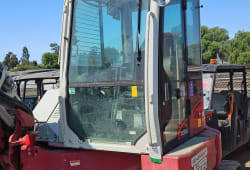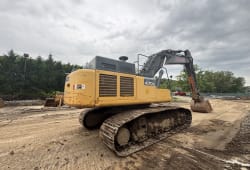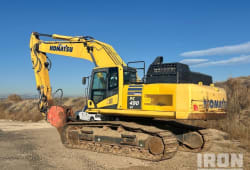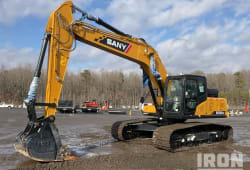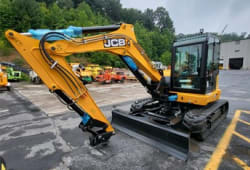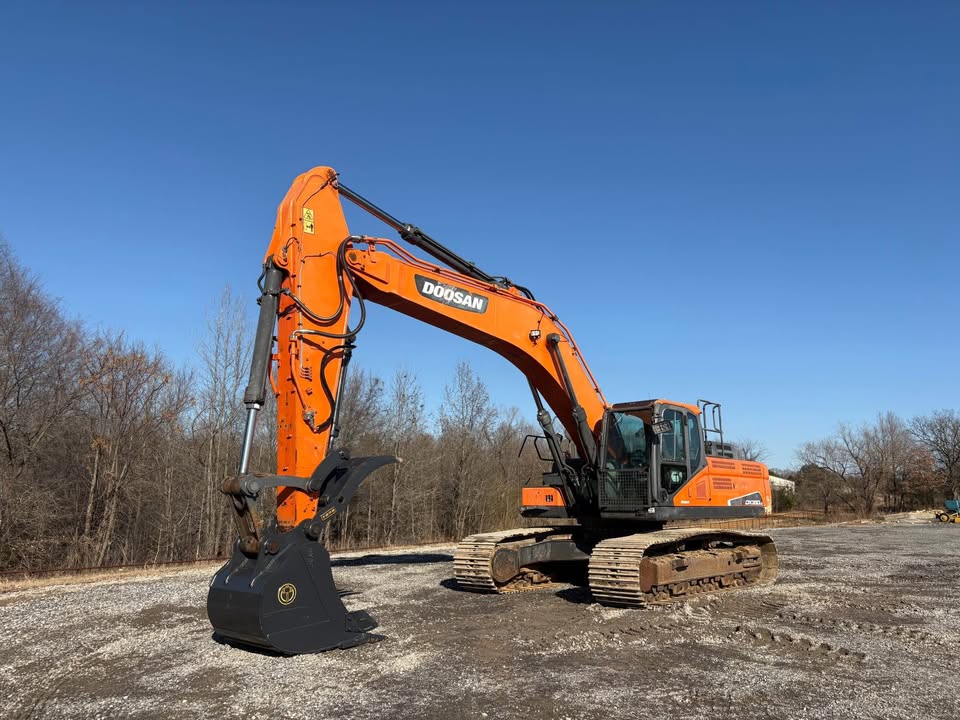Top 7 Most Popular Companies of Excavators
8 Min read
)
May 30, 2023
An excavator is a heavy construction machine used for digging, excavation, and earthmoving tasks. It usually consists of a boom, dipper or stick, and bucket attached to a rotating platform called the house or cab. Excavators are powered by hydraulic systems, allowing for precise control and efficient operation.
Excavators are widely employed in construction, road building, mining, and landscaping projects. They are used for digging, lifting, and moving substantial quantities of soil, rocks, or materials.
There are many types of excavators such as wheeled excavators, standard excavators, dragline excavators, compact excavators, Hydraulic excavators, and crawler excavators. we will explain it step by step in this guide.
Commonly Used Types of Excavators
In this discussion, we will explore different excavator types and machines. There is a wide variety of excavators with unique features and applications.
Hydraulic Excavators
:format(webp))
They are the most widely used type of excavator in the construction industry. They use hydraulic systems to power their movements, including the boom, dipper, and bucket. Hydraulic excavators provide superior digging power, versatility, and precision. They are ideal for a wide range of tasks, including excavation, demolition, material handling, and landscaping
Long Reach Excavators
:format(webp))
Large excavators are specifically designed with extended booms and arms to reach greater depths and distances. They are commonly used in applications where standard excavators cannot reach, such as deep excavation, dredging, and riverbank maintenance. Long-reach excavators provide enhanced flexibility and are ideal for large-scale projects with extended reach capabilities.
Wheeled Excavators
:format(webp))
The wheeled excavator is equipped with wheels instead of tracks, allowing for better mobility and faster travel between job sites. They are commonly used in urban areas, road construction projects, and applications that must frequent transportation. The Wheeled excavator offers excellent maneuverability, making them suitable for tasks that involve frequent repositioning.
Dragline Excavators
:format(webp))
A dragline excavator is a massive machine primarily used in mining and large-scale earthmoving projects. They feature a long boom and a bucket suspended by cables and chains. Dragline excavators are known for their exceptional digging power and ability to handle heavy loads. They are often used for tasks such as stripping overburden, excavating large volumes of earth, and mining operations.
Skid Steer Excavators
:format(webp))
Skid steer excavators, also known as compact excavators or mini excavators, are smaller-sized machines designed for versatility and maneuverability in tight spaces. They are commonly used in landscaping, urban construction, and residential projects. Skid steer excavators offer the advantage of being easily transported and can access areas with limited space.
Suction Excavators
:format(webp))
Suction excavators are also called vacuum excavators or hydro excavators. They use a powerful suction mechanism to extract soil and debris. These machines are great at non-destructive digging. They prioritize precision to protect underground utilities and sensitive areas. Their applications include utility installation, excavation in cramped zones, and archaeological ventures.
Compact Excavators
:format(webp)) as mentioned earlier, are smaller-sized, machines designed for enhanced maneuverability and efficiency in confined spaces. They are also known as mini excavators. They are versatile tools for tasks such as trenching, foundation work, landscaping, and indoor construction and demolition projects. They are highly popular due to their compact size, ease of operation, and ability to access tight areas.
as mentioned earlier, are smaller-sized, machines designed for enhanced maneuverability and efficiency in confined spaces. They are also known as mini excavators. They are versatile tools for tasks such as trenching, foundation work, landscaping, and indoor construction and demolition projects. They are highly popular due to their compact size, ease of operation, and ability to access tight areas.
There are various types of excavators, each with unique features and capabilities. These machines cater to specific job requirements. By comprehending these excavator types, construction professionals and project managers can choose the most suitable one. This ensures the efficient and effective execution of their projects.
Different Attachments and Parts of Excavators
Excavators are versatile machines with hydraulic systems and attachments for digging and holding. They have a rotating cab side for control and a rotating platform for mobility and debris removal.
Bucket: Common attachment for digging and scooping. Different types include ditching buckets for grading stones and trenching buckets for digging trenches.
Auger: Used for boring into the ground. Hydraulic-powered with spiral design. Available in various sizes and can drill holes up to 32 feet deep.
Breaker: Larger than jackhammers, used for breaking rigid surfaces like stone and concrete. Provides high-impact energy up to 1,000 pounds.
Clamp: Allows operators to pick up oversized materials such as tree stumps and concrete. Can be used with buckets or as part of a grapple.
Coupler: Enables quick switching between tools and attachments without a crew. Increases versatility and efficiency on job sites.
These are excavator attachments that have bucket buckets that are widely used in construction sites. Each type has a different bucket capacity and size. These are heavy construction equipment with various applications in landscaping projects and their working conditions depend on their modals and engine power.
Top 7 Manufacturer Companies in The World
When searching for an excavator, there are many manufacturers to explore, each offering various sizes and models to suit different project requirements. At DOZR, you can find a wide selection of excavators available for rent, ranging from 18 tons to 80 metric tons each. Let's delve into some of the well-known brands in the excavator manufacturing industry.
1. Caterpillar
Caterpillar, also known as CAT, is a leading heavy equipment manufacturer. Their excavators, including the popular 200 series, feature fuel efficiency, advanced safety features, and impressive productivity. Caterpillar's largest excavator, the 395 - Tier 4 model, weighs over 100 tons and offers a dig depth of 32 feet.
2. Komatsu
Komatsu was founded in 1917 in Japan and expanded to North America in 1970. They introduced their hydraulic excavators, including the H-Series, to the American market in the 1960s. Offering a range of sizes, from mid-size to large, and surface mining excavators, Komatsu has a suitable excavator for various projects. Their largest model, the PC1250LC-11, has an operating weight of 270,000 lbs, a reach of up to 56 feet, hydraulic cylinders, and a dig depth of 38 feet.
3. John Deere
John Deere, founded in 1837, offers a wide range of excavators, including compact, mid-size, and large models. The JD690 was their first compact excavator introduced in 1969. Their largest model, the 870 P-Tier, provides a digging depth of nearly 37 feet and weighs over 188,000 lbs. With over 20 different types of excavators, John Deere caters to various project requirements.
4. Volvo
Volvo Construction Equipment, founded in 1832, is a leading manufacturer of excavators. Volvo strives for innovation in earthmoving equipment. Their goal is to introduce electric compact excavators and wheel loaders in mid-2020. The company provides a diverse range of options, such as larger crawler excavators, medium crawler excavators, medium-wheeled excavators, and compact excavators.
Their renowned wheeled excavators stand out. The EC950F, their largest model, weighs around 210,000 lbs (105 tons) and can dig up to 30 feet. Volvo's commitment to progress drives its success in the excavator industry.
5. Hitachi
Hitachi, a Japanese company, has manufactured construction equipment since the 1950s. With 37 excavator models, Hitachi is known for innovation in heavy machinery. Their excavator lineup includes various sizes, from the compact ZX160LC-6 to the large ZX890LC-6. Hitachi also produces mining and mini excavators, catering to diverse needs in the industry.
6. Hyundai
Hyundai, established in South Korea in 1985, has become a prominent player in the excavator market. Hyundai offers various models, like compact excavators. They have 16 current and 28 previous models in their portfolio. Ranging from HX130A LCR to HX900L, Hyundai's medium excavators prove their expertise and versatility. The HX130A LCR weighs less than 15 tons, while the HX900L weighs 103 tons.
7. Doosan
Doosan, established in 1977, has been producing excavators since 1978. They entered the American market in 1994. Doosan offers a range of excavators, including crawler, wheeled, and mini excavators. They have 18 products in total. The smallest crawler excavator is the DX140LC-7, weighing 16 tonnes and with a dig depth of over 19 feet. The largest mini excavator made is the DX800LC-7, weighing 90 tonnes and with a dig depth of over 27 feet.
Conclusion
Excavators are versatile machines used for digging and earthmoving tasks in construction projects. Excavators have types like a hydraulic, long-reach, wheeled, dragline, skid steer, suction, and compact. These machines have various attachments for improved functionality, such as buckets, augers, breakers, clamps, and couplers. There are top manufacturers in the industry, like Caterpillar and Komatsu. John Deere, Volvo, Hitachi, Hyundai, and Doosan also provide excavator models.
These models have advanced features and offer high productivity. Renting excavators provides flexibility, and DOZR offers a range of options. Construction professionals can choose the most suitable excavator, sometimes a used excavator can be an ideal one for their projects by understanding the various types and attachments. This understanding ensures the efficient execution of the projects.

Samir Shah is the Co-Founder and Chief Product Officer of Boom & Bucket, where he leads the development of innovative solutions for buying and selling heavy equipment. With a background in engineering, product development, and business strategy, Samir has a track record of taking companies from concept to market success. Previously, he was the Head of Cat Digital Labs at Caterpillar, overseeing digital initiatives and product launches. He holds degrees from MIT Sloan and Carnegie Mellon, and he is passionate about tackling big challenges in underserved industries.
